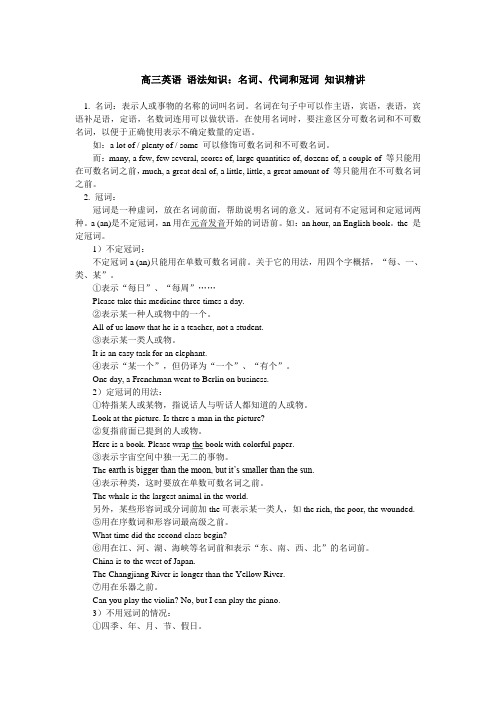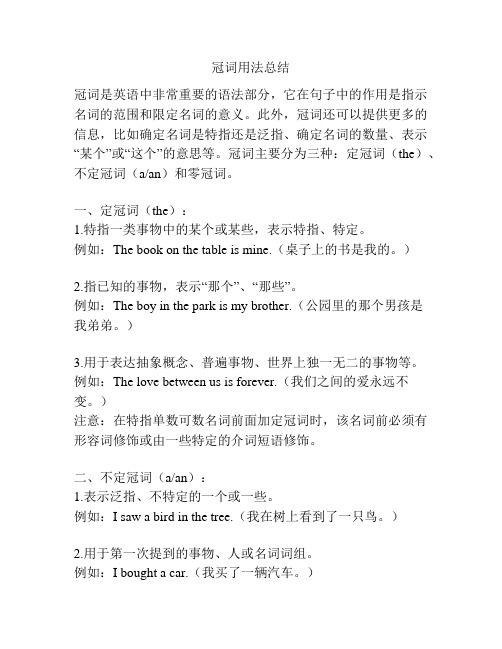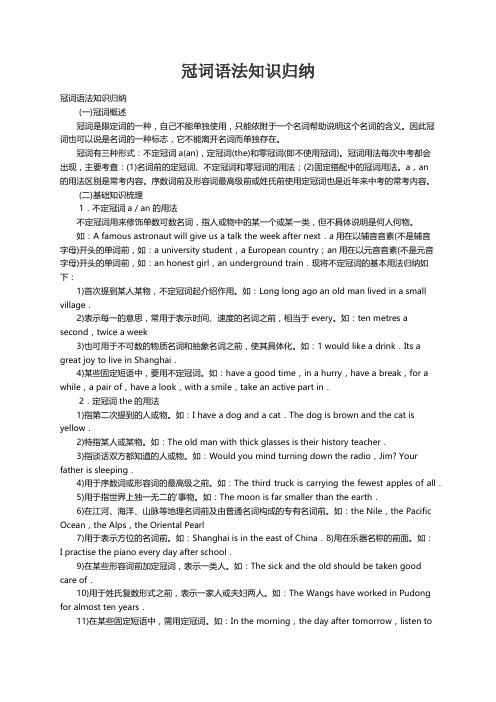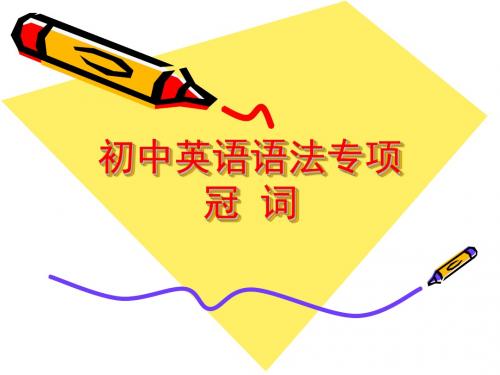语法精讲——冠词
高三英语 语法知识名词、代词和冠词 知识精讲

高三英语语法知识:名词、代词和冠词知识精讲1. 名词:表示人或事物的名称的词叫名词。
名词在句子中可以作主语,宾语,表语,宾语补足语,定语,名数词连用可以做状语。
在使用名词时,要注意区分可数名词和不可数名词,以便于正确使用表示不确定数量的定语。
如:a lot of / plenty of / some 可以修饰可数名词和不可数名词。
而:many, a few, few several, scores of, large quantities of, dozens of, a couple of 等只能用在可数名词之前,much, a great deal of, a little, little, a great amount of 等只能用在不可数名词之前。
2. 冠词:冠词是一种虚词,放在名词前面,帮助说明名词的意义。
冠词有不定冠词和定冠词两种。
a (an)是不定冠词,an用在元音发音开始的词语前。
如:an hour, an English book。
the 是定冠词。
1)不定冠词:不定冠词a (an)只能用在单数可数名词前。
关于它的用法,用四个字概括,“每、一、类、某”。
①表示“每日”、“每周”……Please take this medicine three times a day.②表示某一种人或物中的一个。
All of us know that he is a teacher, not a student.③表示某一类人或物。
It is an easy task for an elephant.④表示“某一个”,但仍译为“一个”、“有个”。
One day, a Frenchman went to Berlin on business.2)定冠词的用法:①特指某人或某物,指说话人与听话人都知道的人或物。
Look at the picture. Is there a man in the picture?②复指前面已提到的人或物。
初高中专题语法精讲《冠词》定冠词+不定冠词+零冠词(具体用法解析+例句)

冠词art.一.分类定冠词the 不定冠词a/an 零冠词二.不定冠词a/an㈠用法①an+以元音音素开头的单数可数名词;a+以辅音音素开头的单数可数名词元音字母:a,e,i,o,uⅠ以元音字母开头,读作辅音的单词A European/unit /university/uniform/useful.../useless.../usual task/united form/one-way street...Ⅱ以辅音字母开头,读作元音的单词An hour/honor/honest boy...②用在可数名词单数前,表示“一.../某一/同一/每一”There is a tiger in the zoo.动物园有一只老虎A gentle man wants to see you.有一位先生要见你They are nearly of an age.他们几乎同岁We go shopping once a week.我们每周购物一次③表示一类人/东西A tiger can be dangerous.老虎是危险的④“a/an+序数词”表示“又一、再一”They want a third child.他们还想再要一个小孩⑤what(感叹句)/such/many/half...+a/an+(adj.)+单数名词Many a man is fit for the job.不止一个人适合这个工作I have never seen such a strange animal.⑥当名词前的形容词前有so/as/too/how(感叹句)/however/enough...修饰时,a/an置于形容词后So tall a man/too long a distance/how cute a girl=what a cute girl⑦quite/rather与名词单数连用,a/an置于其后Quite a good doctor/quite a lot⑧在as/though引导的让步状语从句中,当表语为形容词修饰的名词时,a/an置于adj.后Brave a man as/though he is,he trembles at the sight of snakes.㈡固定搭配Havehave a bath/break/cough/cold/drink/fever/holiday/ look(at)/pain/rest/shower/swim/try/(nice)trip/;have a word/talk with sb.与某人交谈(have words with sb.与...争吵);have a good/happy time 玩的开心;have a population of有...人口;have a gift for对...有天赋Inin a/one word总而言之;in a sense 在某种意义上in a moment 立刻;once in a while 时不时,偶尔;in a hurry 急匆匆地;in a way某种程度上Asas a result结果;as a rule 通常,照例;as a result 因此;as a matter of fact 事实上;as a whole 大体上MakeMake an apology道歉;Make a choice;make a decision;make an effort努力;make a face做鬼脸;make a fire生火;make a fool of愚弄;make a living 谋生;make a mistake犯错;make a plan;make a suggestion其他A waste of浪费;a matter of大约、左右;after a while 一会儿后;all of a sudden 突然;at a blow 一下子;at a loss不知所措;at a distance保持一定距离;Come to an agreement;come to an end结束;come to a conclusion得出结论;Do a good deed做好事;do sb. A favor;for a while/time暂时;Get a lift/ride搭车;give a lesson授课;give a smile/laugh/shout;give sb. a hand;go on a diet节食;keep an eye for...对...有鉴赏力;keep an eye on照看,关注;lend a hand;lead/live a happy life;once upon a time 从前;put an end to使...结束;Pay a visit拜访;Take a bath;take a rest/break休息下;take a seat入座;take a walk散步;turn a deaf ear to充耳不闻;turn a blind eye to视而不见注意:通常成对出现的名词(被视为一套或一体),一般只用一个不定冠词。
冠词用法总结

冠词用法总结冠词是英语中非常重要的语法部分,它在句子中的作用是指示名词的范围和限定名词的意义。
此外,冠词还可以提供更多的信息,比如确定名词是特指还是泛指、确定名词的数量、表示“某个”或“这个”的意思等。
冠词主要分为三种:定冠词(the)、不定冠词(a/an)和零冠词。
一、定冠词(the):1.特指一类事物中的某个或某些,表示特指、特定。
例如:The book on the table is mine.(桌子上的书是我的。
)2.指已知的事物,表示“那个”、“那些”。
例如:The boy in the park is my brother.(公园里的那个男孩是我弟弟。
)3.用于表达抽象概念、普遍事物、世界上独一无二的事物等。
例如:The love between us is forever.(我们之间的爱永远不变。
)注意:在特指单数可数名词前面加定冠词时,该名词前必须有形容词修饰或由一些特定的介词短语修饰。
二、不定冠词(a/an):1.表示泛指、不特定的一个或一些。
例如:I saw a bird in the tree.(我在树上看到了一只鸟。
)2.用于第一次提到的事物、人或名词词组。
例如:I bought a car.(我买了一辆汽车。
)3.在表示职业或身份的名词前,用a表示“一个”,表达所从事的职业或身份。
例如:He is an engineer.(他是一名工程师。
)4.在一些固定搭配中,表示“某个”。
例如:I will come back in a week.(我将在一个星期后回来。
)5.在以辅音音素开头的音节前使用a,以元音音素音节开头的音节前使用an。
例如:a book(一本书)、an apple(一个苹果)。
三、零冠词:1.表示泛指、不特定、抽象概念、普遍事物等。
例如:Dogs are loyal pets.(狗是忠诚的宠物。
)2.在复数名词前表示泛指。
例如:I like dogs.(我喜欢狗。
冠词总结知识点归纳

冠词总结知识点归纳一、冠词的定义冠词是指定名词词义的虚词。
它位于名词之前,有时在其前面可以有形容词或其他修饰词。
冠词的使用是语言中一个非常基本的语法规则,是学习英语的重要一环。
在英语语法中,冠词分为三种:不定冠词a/an,定冠词the和零冠词。
二、不定冠词1. 不定冠词的定义不定冠词有两个形式,即a和an,表示泛指或不特定的人或事物。
a用于辅音开头的词前,an用于元音开头的词前。
2. 不定冠词的使用(1)用在可数名词的单数形式前,泛指一个人或事物。
例:I saw a dog in the street.(2)表示职业、国籍、宗教或宗教信仰的一个人。
例:He is a doctor.(3)表示一种特殊的人或事物。
例:She lived in a small house.3. 注意事项(1)不定冠词的a变成an时,只是音标的问题,而不是词的本身。
(2)a和an本身没有复数形式,也没有限定词的概念。
三、定冠词1. 定冠词的定义定冠词the有三种形式,即普通形式the,音标为[ðə];元音开头名词前的形式the,音标为[ði:];辅音开头连读时的形式the,音标为[ðə]。
定冠词the表示特指,用于特定的人或事物。
2. 定冠词的使用(1)用在特指的可数名词或不可数名词前,表示特定的人或事物。
例:The boy is playing in the garden.(2)用于上文已经提到过的名词前,表示特指。
例:She opened the door and went out.3. 注意事项(1)the没有复数形式,也没有限定词的概念。
(2)the不同于a或an,the并不表示非常特指。
四、零冠词1. 零冠词的定义零冠词指的是没有冠词的情况,即名词前没有任何限定词。
这种情况并不表示名词没有冠词,只是在语法上的规定。
2. 零冠词的使用(1)通常用于不可数名词或复数名词前。
例:She has long hair.(2)用于专有名词前,比如人名、地名、国名等。
冠词语法知识归纳

冠词语法知识归纳冠词语法知识归纳(一)冠词概述冠词是限定词的一种,自己不能单独使用,只能依附于一个名词帮助说明这个名词的含义。
因此冠词也可以说是名词的一种标志,它不能离开名词而单独存在。
冠词有三种形式:不定冠词a(an),定冠词(the)和零冠词(即不使用冠词)。
冠词用法每次中考都会出现,主要考查:(1)名词前的定冠词、不定冠词和零冠词的用法;(2)固定搭配中的冠词用法。
a,an的用法区别是常考内容。
序数词前及形容词最高级前或姓氏前使用定冠词也是近年来中考的常考内容。
(二)基础知识梳理1.不定冠词a/an的用法不定冠词用来修饰单数可数名词,指人或物中的某一个或某一类,但不具体说明是何人何物。
如:A famous astronaut will give us a talk the week after next.a用在以辅音音素(不是辅音字母)开头的单词前,如:a university student,a European country;an用在以元音音素(不是元音字母)开头的单词前,如:an honest girl,an underground train.现将不定冠词的基本用法归纳如下:1)首次提到某人某物,不定冠词起介绍作用。
如:Long long ago an old man lived in a small village.2)表示每一的意思,常用于表示时间、速度的名词之前,相当于every。
如:ten metres a second,twice a week3)也可用于不可数的物质名词和抽象名词之前,使其具体化。
如:1 would like a drink.Its a great joy to live in Shanghai.4)某些固定短语中,要用不定冠词。
如:have a good time,in a hurry,have a break,for a while,a pair of,have a look,with a smile,take an active part in.2.定冠词the的用法1)指第二次提到的人或物。
初高中专题语法精讲《冠词》定冠词+不定冠词+零冠词(具体用法解析+例句)

冠词art.一.分类定冠词the 不定冠词a/an 零冠词二.不定冠词a/an㈠用法①an+以元音音素开头的单数可数名词;a+以辅音音素开头的单数可数名词元音字母:a,e,i,o,uⅠ以元音字母开头,读作辅音的单词A European/unit /university/uniform/useful.../useless.../usual task/united form/one-way street...Ⅱ以辅音字母开头,读作元音的单词An hour/honor/honest boy...②用在可数名词单数前,表示“一.../某一/同一/每一”There is a tiger in the zoo.动物园有一只老虎A gentle man wants to see you.有一位先生要见你They are nearly of an age.他们几乎同岁We go shopping once a week.我们每周购物一次③表示一类人/东西A tiger can be dangerous.老虎是危险的④“a/an+序数词”表示“又一、再一”They want a third child.他们还想再要一个小孩⑤what(感叹句)/such/many/half...+a/an+(adj.)+单数名词Many a man is fit for the job.不止一个人适合这个工作I have never seen such a strange animal.⑥当名词前的形容词前有so/as/too/how(感叹句)/however/enough...修饰时,a/an置于形容词后So tall a man/too long a distance/how cute a girl=what a cute girl⑦quite/rather与名词单数连用,a/an置于其后Quite a good doctor/quite a lot⑧在as/though引导的让步状语从句中,当表语为形容词修饰的名词时,a/an置于adj.后Brave a man as/though he is,he trembles at the sight of snakes.㈡固定搭配Havehave a bath/break/cough/cold/drink/fever/holiday/ look(at)/pain/rest/shower/swim/try/(nice)trip/;have a word/talk with sb.与某人交谈(have words with sb.与...争吵);have a good/happy time玩的开心;have a population of有...人口;have a gift for对...有天赋Inin a/one word总而言之;in a sense 在某种意义上in a moment 立刻;once in a while 时不时,偶尔;in a hurry 急匆匆地;in a way某种程度上Asas a result结果;as a rule 通常,照例;as a result 因此;as a matter of fact 事实上;as a whole大体上MakeMake an apology道歉;Make a choice;make a decision;make an effort 努力;make a face做鬼脸;make a fire生火;make a fool of愚弄;make a living 谋生;make a mistake犯错;make a plan;make a suggestion其他A waste of浪费;a matter of大约、左右;after a while 一会儿后;all ofa sudden 突然;at a blow 一下子;at a loss不知所措;at a distance保持一定距离;Come to an agreement;come to an end结束;come to a conclusion得出结论;Do a good deed做好事;do sb. A favor;for a while/time暂时;Get a lift/ride搭车;give a lesson授课;give a smile/laugh/shout;give sb.a hand;go on a diet节食;keep an eye for...对...有鉴赏力;keep an eye on照看,关注;lend a hand;lead/live a happy life;once upon a time 从前;put an end to使...结束;Pay a visit拜访;Take a bath;take a rest/break休息下;take a seat入座;take a walk散步;turn a deaf ear to充耳不闻;turn a blind eye to视而不见注意:通常成对出现的名词(被视为一套或一体),一般只用一个不定冠词。
“定冠词+名词”的认知阐释

“定冠词+名词”的认知阐释语法精讲—冠词一、不定冠词 a/an 的用法1.a 用于辅音音素开头的单数可数名词前。
如:a woman, a book, a photo, a pen2.an 用于元音音素开头的单数可数名词前。
如:an apple, an egg, an honest student, an interesting book注:此处的辅音音素和元音音素是指单词发音的第一个音素,而不是单词的首字母。
如 a university, an umbrella。
3.用于第一次提到的人或事物之前。
例如:I have a new pen. 我有一支新笔。
4.对某人、某类人或事物的总称。
例如:A girl is waiting for you.有个女孩正在等你。
5.用于固定搭配或习惯用法。
如:have a good time, in a minute, go for a walk二、定冠词 the 的用法1.用于世界上独一无二的事物之前。
例如:the moon, the sun, the earth2.用于特指的人、物或上文提过的人或物。
如:There is a boy over there and the boy is crying.那里有一个男孩,他正在哭。
3.用于形容词前表示一类人。
如:the rich, the poor, the young, the old4.用于序数词和形容词最高级前。
如:He is the tallest in our class. 他是我们班最高的。
We live on the third floor. 我们住在三楼。
5.用在表示乐器名称的名词前。
如:play the piano/ violin 弹钢琴 / 拉小提琴注意:中国乐器前不用定冠词 the6.用于姓氏复数前,表示“一家人”。
如:The Greens are in the same pany.格林一家在同一家公司。
初中英语语法冠词精讲

•
• • • •
(B )10. Which of the following phonetic transcription(音标) is right for the phrase “the egg”? A. /ðə eg/ B. /ði eg/ C. /θi eg/ D. /di eg/
解析:考查定冠词。定冠词the在 元音因素前发[ði]而不发[ðə]。[e]是 元音,故选B。
解析:考查冠词。go to school 固定用 法, go to a/the cinema 也是固定用法, a/the cinema 表示一类事物。
•
( B )3. We will see ________ even stronger China in _____near future. A. a; the B. an; the C. the; a D. an; a 解析:考查冠词in the near future“在 不久的将来”是个固定搭配;even是以 元音因素开头的词,故选B。
•
• • •
•
( C )5. —Look at ________ skirt. I bought it for mother on Mother’s Day, isn’t it nice? —Oh, what ________ nice present! A. a; a B. a; the C. the; a D.a; 不填 解析:考查冠词。特指这条裙子用冠词 the; 感叹句中只能用不定冠词不能用定冠 词。
初中英语语法专项 冠 词
• • • •
要点梳理
中考对冠词的考查主要为: 1. 冠词的基本用法; 2. 不用冠词 的情况; 3. 习惯用语中冠词的位置及使用。
- 1、下载文档前请自行甄别文档内容的完整性,平台不提供额外的编辑、内容补充、找答案等附加服务。
- 2、"仅部分预览"的文档,不可在线预览部分如存在完整性等问题,可反馈申请退款(可完整预览的文档不适用该条件!)。
- 3、如文档侵犯您的权益,请联系客服反馈,我们会尽快为您处理(人工客服工作时间:9:00-18:30)。
3.指世上独一无二的事物或用于对两个人或
事物比较时起特指作用的比较级前。 He is the taller of the two boys.两个男孩中他 较高点。 the sun, the sky, the moon, the earth
4 . 与 单 数 名 词 连 用 表 示 一 类 事 物 , 如 : the dollar“美元”; 或与形容词或分词连用表示一类 人,如:the rich“富人”;the living“生者”。 5.用在序数词和形容词最高级及形容词 only, very, same 等前面。 Where do you live?I live on the second floor. 你住在哪?我住在二层。 That's the very thing I've been looking for. 那正是我要找的东西。
(2)当名词前面的形容词前有 so,how,too 等词时,不定冠词应放在形容词后。如: She was so nice a girl that she took the blind man to the station. 她是如此好的一个女孩,她把那位盲人带到了车站。 How nice a film this is! 这是多么好看的一部电影啊! (3)当名词前面有形容词和 quite,rather 或 very 时,不定冠词置于 quite 或 rather 之后, very 之前。如: quite a good book,rather a useful tool,a very interesting story
3.不可数名词前一般不用冠词。 Which
does he like better, fish or chicken? 他更喜欢哪一个,鱼还是鸡? 4.泛指的复数名词前不用冠词。 Animals live in the forest. 动物生活在树林里。
5.与by连用的交通工具前不用冠词,但与take或介 词连用时,名词前要加冠词。 They often go to school by bus. 他们通常做公共汽车去上学。 take a bus,in a boat,on the bike 6.在某些固定的词组或习语中,不用冠词。 face to face,watch TV,step by step,at first/last, in trouble/danger,on/in time,go to school/work, at noon/night
9.用于方向名词或表示江河、山脉、海峡等专有 地理名称前。 in the southeast of,at the back of,the Red Sea 10.用在逢十的复数名词前,表示年代,也指人的 大约岁数。 The young girl is in the twenties. 这个年轻的女孩大约二十几岁。 The war broke out in the forties. 这场战争发生在40年代。
6.当名词被其他词修饰时,不定冠词 a 或 an 的位置应注意: (1)当名词被 such,half,what,many 修饰时,不定冠词放在这些词之后。如: He left in such a hurry that he forgot to close the door. 他离开得如此匆忙以至于忘了关门。 It took me half an hour to write the letter. 写那封信花了我半个小时。 (但在美国,半个小时也可以说成 a half hour。) What an interesting book it is! 这是多么有趣的一本书啊! Many a man has gone to the big cities for work. 许多人到大城市去打工了。
第10讲 语法精讲——冠词
中考对冠词的考查主要集中在以下几点: 1.不定冠词 a, an 的用法区别。 2.定冠词 the 的用法。 3.不用冠词的情况。 4.习惯用语中冠词的用法。 考查冠词的形式一般为单项选择,有时也会在完形填空、完成句子等题中出现。
单数可数 上文提到过的人或事物 名词前一 特 被限制性修饰语所限定的人或事物 定要用 the指 说话双方所默认的人或事物 冠词 世上独一无二的事物 指类别
2.有定冠词与无定冠词的区别 go to school上学 是学生 (1) go to the school到学校去不一定是学生 go to bed就寝,上床睡觉 (2)go to the bed向床边走去,走到床前 不一定是去睡觉
in (3) in at (4) at
5.用于某些习语中,如:
a
little/few/bit,in a hurry,catch a cold, have a good time,have a rest=rest,after a while,in a word
零冠词
1.在专有名词前不加冠词,如国名、省名、城市 名、街名、公园名等。 Sanya is in Hainan Province. 三亚在海南省。 We live in China. 我们住在中国。 2.一日三餐、球类运动和学科前不加冠词。 He went to school without breakfast this morning. 早上他没吃早饭就去上学了。 They like playing football after school. 他们喜欢放学后踢足球。 I like English very much. 我非常喜欢英语。
泛指单一,每一,任一事物 a n 指类别
上文提到的人或事物 the 被限制性修饰语所限定的人或事物 复数可数 特指说话双方所默认的人或事物 名词,不可 数名词前 泛指的人或事物 零冠词 指类别
考 点一 定冠词的用法
定冠词 the,来表示某个或某些特定的人或东 西。 1.特指双方都明白的人或物。 Take the medicine.把药吃了。 2.上文提到过的人或事。 He bought a house. I've been to the house. 他买了幢房子。我去过那幢房子。
a/an
1.不定冠词用来表示“一”这个数量,其意思和 “one”差不多。 —What can I do for you, madam?要点什么,女士? —I want an orange skirt for my daughter. 我想为我女儿买条橘黄色的裙子。 2.泛指人或事物的某一类,尤其是作表语时要用a +单数名词,而不用the+单数名词。 The dog is an honest animal to human beings. 狗是对人类忠诚的动物。
3.用于表示时间、速度、价格等意义的名词
前,有“每一”之义,相当于every。 —How much is the meat? 肉多少钱? —It's eight yuan a kilo. 8块钱每公斤。 4.泛指某人或某物。 A boy is looking at you. 一个男孩在看你。
next year明年 (9) the next year第二年 by sea (10) by the
乘船 sea在海边
in bed睡、病、躺在床上 (11) in the b the earth在地球上
3.序数词前面用定冠词与不定冠词的区别 “the+序数词”表示“第几„„”;“a+序数词”表示“又一,再一”。如: The cake is delicious,and I would like a_second one. 蛋糕很好吃,我想再吃一块。 4.a number of 与 the number of 的辨析 a number of 意思是“许多”,相当于 a lot of;the number of 意思是“„„的数目,„„ 的数量”,当它作主语时,谓语动词用单数形式。如: A number of students like playing computer games. 许多学生喜欢玩电脑游戏。 The number of the students is about 1,500 in our school. 我们学校学生的人数大约是 1 500。 5.在句型“动词+人+介词+the+人体部位”中要用 the,而不用物主代词。如: take sb. by the hand 抓住某人的手 hit sb. on the head 打某人的头 pat sb. on the shoulder 拍某人的肩 hit sb. in the face 打某人的脸
6.用在表示西洋乐器的名词之前,但球类运 动前不加 the。 play the piano 弹钢琴 7 .用在姓氏的复数名词之前,表示“一家 人”或“夫妇二人”。 the Greens 格林一家人(或格林夫妇) 8.用在惯用语中。 in the morning/afternoon/evening, in the end,by the way, at the age of,at the moment 等。
hospital因病住院 the hospital在医院里不一定是病人 table吃饭 the table在桌子旁边
at school在上学 (5) at the school在学校里 in class在上课 (6) in the class在班级里 in future今后 (7) in the future将来 in front of在„„外部的前面 (8) in the front of在„„内部的前面
